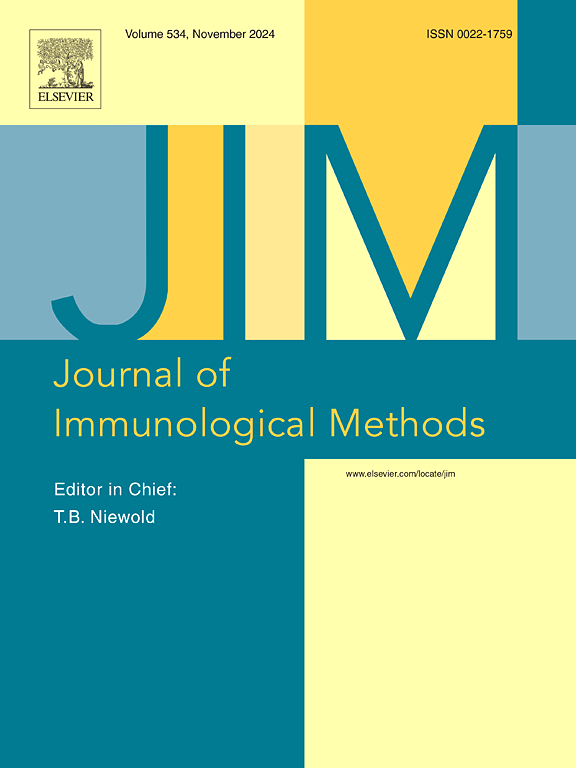Development of microfluidic ELISA for measuring humoral responses to clostridial antigens in vaccinated cattle
IF 1.6
4区 医学
Q4 BIOCHEMICAL RESEARCH METHODS
引用次数: 0
Abstract
Clostridial diseases significantly threaten livestock health, particularly in cattle, underscoring the need for effective vaccination strategies. This study develops and optimizes a microfluidic-based enzyme-linked immunosorbent assay (ELISA) for the rapid (< 1 h) and cost-effective measurement of IgG antibody levels against various clostridial toxins in cattle vaccinated with a multivalent clostridial vaccine. This assay requires only 5 μL of sample and reagent volume, demonstrating high repeatability and reproducibility with coefficient of variation (CV) values ranging from 0.1 % to 8.5 % across all tested clostridial antigens. The Limit of Detection (LOD) of the assay ranged from 1:150 to 1:800, allowing for sensitive detection of antibody levels. For Clostridium perfringens ε toxin, antibody titers were measured using a commercial kit, while microfluidic ELISA was applied to assess titers against tetanus toxoid, Clostridium septicum α toxin, Clostridium novyi type B toxins, and Clostridium sordellii toxins. Significant increases in IgG antibody levels were observed for C. perfringens ε toxin and tetanus toxoid following both primary and booster vaccine doses, peaking by day 42. Antibody titers against C. septicum α toxins and C. novyi type B toxins increased after the primary dose, peaking at day 42, while no booster effect was seen for C. sordellii. These findings highlight the utility of microfluidic ELISAs as a practical and efficient tool for assessing humoral immune responses to clostridial toxins in vaccinated cattle, with potential application for the herd level disease surveillance and vaccine efficacy assessment.
微流控ELISA法测定接种牛对梭菌抗原体液反应的建立。
梭菌病严重威胁牲畜健康,特别是牛的健康,因此需要有效的疫苗接种战略。本研究开发并优化了一种基于微流体的酶联免疫吸附试验(ELISA),用于快速(< 1 h)和经济有效地测量接种了多价梭菌疫苗的牛抗各种梭菌毒素的IgG抗体水平。该分析只需要5 μL的样品和试剂体积,具有高重复性和再现性,变异系数(CV)值在0.1 %至8.5 %之间。检测限(LOD)范围为1:150至1:80,可灵敏检测抗体水平。产气荚膜梭菌ε毒素抗体滴度采用市产试剂盒检测,破伤风类毒素、败血症梭菌α毒素、新梭菌B型毒素和索氏梭菌毒素滴度采用微流控ELISA检测。产气荚膜原杆菌ε毒素和破伤风类毒素IgG抗体水平在初次和加强接种后均显著升高,在第42天达到峰值。第一次给药后,针对败血症c α毒素和novyi C. B型毒素的抗体效价升高,在第42天达到峰值,而对梭氏C.没有增强作用。这些发现强调了微流体elisa作为评估接种牛对梭状芽孢杆菌毒素的体液免疫反应的实用和有效工具的实用性,并具有潜在的应用于牛群水平的疾病监测和疫苗功效评估。
本文章由计算机程序翻译,如有差异,请以英文原文为准。
求助全文
约1分钟内获得全文
求助全文
来源期刊
CiteScore
4.10
自引率
0.00%
发文量
120
审稿时长
3 months
期刊介绍:
The Journal of Immunological Methods is devoted to covering techniques for: (1) Quantitating and detecting antibodies and/or antigens. (2) Purifying immunoglobulins, lymphokines and other molecules of the immune system. (3) Isolating antigens and other substances important in immunological processes. (4) Labelling antigens and antibodies. (5) Localizing antigens and/or antibodies in tissues and cells. (6) Detecting, and fractionating immunocompetent cells. (7) Assaying for cellular immunity. (8) Documenting cell-cell interactions. (9) Initiating immunity and unresponsiveness. (10) Transplanting tissues. (11) Studying items closely related to immunity such as complement, reticuloendothelial system and others. (12) Molecular techniques for studying immune cells and their receptors. (13) Imaging of the immune system. (14) Methods for production or their fragments in eukaryotic and prokaryotic cells.
In addition the journal will publish articles on novel methods for analysing the organization, structure and expression of genes for immunologically important molecules such as immunoglobulins, T cell receptors and accessory molecules involved in antigen recognition, processing and presentation. Submitted full length manuscripts should describe new methods of broad applicability to immunology and not simply the application of an established method to a particular substance - although papers describing such applications may be considered for publication as a short Technical Note. Review articles will also be published by the Journal of Immunological Methods. In general these manuscripts are by solicitation however anyone interested in submitting a review can contact the Reviews Editor and provide an outline of the proposed review.

 求助内容:
求助内容: 应助结果提醒方式:
应助结果提醒方式:


